Nature, in the beauty of its multiplicity, welcomes its creatures within itself, bound by a mysterious force that acts undisturbed and unites, in the name of Nature itself, the infinite manifestations of its creative energy. Within this context, we find Man, the Animal and the investigations of Tiziana Pers (1976), visual artist and activist represented by FineArtX (www.fineartx.com) Prometeogallery Ida Pisani and R&P Contemporary Art. She focuses her research on the themes of the animal issue and the parallels between the different species. Daughters of a harmonic and cosmic vision, the works of Pers teach themselves precious lessons. In fact, the idea that everything in the universe is intimately related could strengthen our respect for the environment and our fellow human beings; therefore, a new ecological awareness, fundamental for the times in which we live, can also develop. But let’s get to know the artist better.
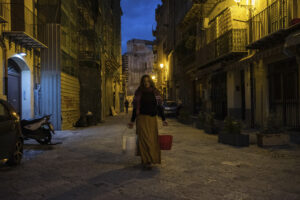
Tiziana Pers, ART_HISTORY – Vucciria, 2018, print on Canson cotton paper mounted on dibond, photo Umberto Santoro, courtesy the artist
Antonella Buttazzo: How and when was this idea of deeply investigating through art the relationship between man and animal born?
Tiziana Pers: My research has always focused on the relationship with animal otherness. I was four years old when I met a young pony on a farm about to be slaughtered. With my mother we managed to save him and it stayed with me for all his life (twenty-nine years) until it died in my arms. I think this little episode has forever changed my perspective on the other, opening a series of questions. Not only about the animal, but above all about who the other is for me. As a young girl, I ran a stable with my family and I continued to save horses from the slaughterhouse, often exchanging them for my paintings, a gesture that would become central to my artistic research. When, to subtract a black Trakehner from its fate, I entered a slaughterhouse, nothing was the same as before. It was like a trip to hell and I immediately became a vegetarian. Over time I then began to question the objectification of the bodies of non-human animals that were part of my life: breeding horses, separating foals from their mothers to sell them, participating in competitions, using bits and spurs, up to think about the legitimacy of mounting another individual or not. So I began to investigate, with every language that I felt mine, the parallels and connections between colonialism, racism, sexism, capitalism, speciesism and the domination over nature. At the same time, I’m interested in the different possibilities of coexistence in a more biocentric, and perhaps posthuman perspective, with the rest of the living bodies.
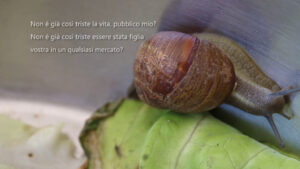
Tiziana Pers, ART HISTORY / Municeddhe, le dormienti, 2022, installation view, Prometeo Gallery Ida Pisani, photo Erjola Zhuka, courtesy the artist, Prometeo Gallery Ida Pisani Milano-Lucca e R&P Contemporary Art
We always tend to consider animals inferior, without reflecting on the fact that man is too. In your opinion, how does man differ from animals and vice versa?
‘What is it like to be a bat?’ wrote Thomas Nagel[1], with the intention of asking not what it would be like for a human animal to be in the body of a bat, but what it means for a bat to live its life. The answer is that we will never know. Just as not even a cow will know. The point is not in what we are different, or in what we are similar, but in what kind of imaginary we want to give shape. Until now these imaginaries have been anthropocentric and profoundly speciesist. Yet I think back to the magic of the Chauvet cave: 40,000 years ago, in the first known forms of visual art, there were women (and perhaps also men) who immortalized the ecstasy of observing a multitude of other forms of life on the walls of a cave. Not hoping for predation, but looking with amazement and wonder at the dynamics of the herd, at the possible shamanic hybridization. Last year at the Spazzapan Museum of Contemporary Art in Gradisca, with the curatorship of the RAVE metaproject together with Gabi Scardi, we created the international collective AAA Animal Among Animals towards the world to come. The exhibition brought together works by male and female artists who look at the issue of animality. The attention to the theme fits fully into the context of an increasingly urgent critical reflection regarding the pressures to which the ecosystem has been subjected. The instability that our time is having to face is in fact manifesting itself in its cogency. If the pandemic has exposed human vulnerability, the violence of the ongoing climate change has placed our species before its responsibilities towards every inhabitant of the planet, human and non-human. Phenomena such as drought capable of drying up rivers and burning woods, as well as floods and environmental disasters, have found every form of life unprepared in recent decades, leading a frightening number of living beings, plants and animals, to their death. In this scenario, which has led us to experience the limits of our anthropocentric action, the connection between human and non-human animals becomes central. The type of relationship we want to redesign, the ability to recognize the other not as an object to be treated, but as a sentient subject to be respected, will help decree our shared fate. Even mealtimes, central to the rituals of every people, can be invested with a new conviviality where animal pain is absent and our impact on the planet can become lighter. It is urgent that the human species finally recognizes itself as an animal among animals: we must get off the pedestal that we have built for ourselves, in a world where we are increasingly alone.
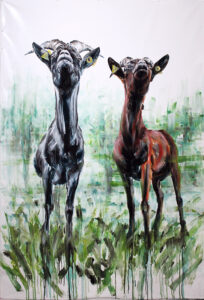
Tiziana Pers, ART_HISTORY – Bruce and William, 2022-2023, oil and pure pigments on canvas, cm 235 x 163, courtesy Prometeogallery Ida Pisani e R&P Contemporary Art
Which expressive medium, do you believe, therefore, is better for reaching human consciences?
It depends a lot on the context where you go to work, each job is a world in itself. I often combine multiple means of expression together, breaking down or thinning the barriers between one and the other.
ART _ HISTORY is the translation of your thought expressed in your previous answers. But what does it consist of and what else does it reveal about you as an artist?
ART_HISTORY rrepresents one of the cornerstone projects of my research, and, perhaps even more radically, of my life. It consists of exchanging one of my paintings for an animal destined for slaughter: horse, donkey, rabbit, lamb, chicken, pig, duck, goat, cow, goose… depending on the project. The painting is the same height or size as the rescued animal. I don’t decide who will come with me: the butcher, or merchant, or farmer makes the choice. A contract ratifies the exchange. It is a real act that allows you to redeem a life through art, without the use of money, and opens up several questions: is it possible to give an economic value to a sentient being? What about an artwork? And at the same time it wonders: can art save a life? Today we are quite aware of the devastating pain caused to millions of individuals and of the environmental impact of animal farming: from climate change to imbalances in the distribution of resources, from water waste to deforestation, yet collective choices remain largely unchanged. The performance therefore, focusing from time to time on a specific individual, questions how aware we are of our daily gestures, how much they affect every life, and ecosystems as a whole.

Tiziana Pers, ART_ HISTORY – Bruce, 2021 paper contract (left), William, 2021 paper contract (right), courtesy RAVE East Village Artist Residency, Prometeogallery Ida Pisani e R&P Contemporary Art
Would you like to tell us about your painting Bruce and William exhibited at the Mac Museum of Contemporary Art in Lissone?
Currently one of my projects from the ART _HISTORY series is exhibited at the MAC Museum of Contemporary Art in Lissone: it is the large-scale painting Bruce and William, together with the two exchange contracts. In the spring of 2021 I had rescued two very young male goats destined for Easter slaughter from an organic dairy goat farm. Given their fragile condition, any change could have been dangerous and, on the advice of the veterinarian, we decided to keep them at the farm until the end of weaning with the artificial milk they had drunk from the first day of life from the teats of the automatic feeding machine, because in this way they would have more hope of surviving. Upon their arrival at the RAVE shelter, both animals were still malnourished and riddled with parasites. The condition of Bruce, the youngest, was so serious that the kid was struggling to stand up. It was necessary to be near it often, lift it off the ground, give it vitamins and supplements, medicate and treat it continuously. After numerous therapies and after various analyzes and checks, the two kids had begun to regain energy, and to feel better day by day. Two years later, the two goats have grown very tall, and lead a very interactive life in the refuge. They spend a long time playing, even in a way that can appear violent. From time to time they stop and stare at a point on the horizon, perhaps looking for something that we are no longer able to see. The Bruce and William project, presented for the first time at Artissima 2022 by the Prometeo gallery, was selected by the curator Gabi Scardi to be presented at the historic Premio Lissone, exhibited in the Grand Prix category (reserved for mid-career artists), among the exhibition she curated Pittura come pratica progettuale. The exhibition at the MAC, open until 17 September 2023, in fact presents the Lissone Prize according to a renewed structure, conceived by the artistic director Francesca Guerisoli, which sees the production of an exhibition project made up of four exhibitions. Based on a concept, each curator selected five proposals, for a total of twenty artists invited to the Prize. On 22 June, again as part of the Lissone Prize, a meeting entitled Art, animal otherness and political commitment was held, which was the first of a series of public events. Together with me, other artists present with their works in the exhibition participated in the meeting: Isabella Pers, my sister with whom I founded the RAVE metaproject, Sonia Arienta and Simona Da Pozzo. We spoke with Gabi Scardi, Isabella Garlati, vice-president of ENPA Monza and Brianza and Francesca Guerisoli. The meeting, organized in collaboration with RAVE East Village Artist Residency and with the participation of ENPA, the National Animal Protection Body, focused on new artistic experiences that address the theme of the relationship with the animal world. Pictorial practice and cultural commitment are proposed in projects in which art goes beyond the margins of representation and relates to a reality that increasingly requires a new gaze, capable of seeing even beyond our species. The latest issue of the journal of critical studies on animality Animot and the RAVE meta-project were also presented.
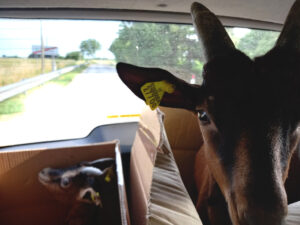
Tiziana Pers, ART HISTORY _ Bruce and William, 2021 / 2022, video frame, courtesy Prometeogallery Ida Pisani, R&P Contemporary Art, RAVE East Village Artist Residency
It is in this context that the RAVE project is inserted.
RAVE East Village Artist Residency is a meta-project and artist residency founded by my sister Isabella and I that opens the discussion on the role of contemporary art towards animal otherness, in a place where animals rescued from slaughterhouse live through my practice Art_History and trees saved from felling. The last RAVE appointment was held on July 2nd in our headquarters in the historic village of Soleschiano (Manzano, Ud). Here, around the centuries-old mulberry tree rescued and transplanted into the meadows among the animals that escaped slaughter, the round table IL TEMPO VENTURO came to life. The relationship with the ‘other’ animals, outside and inside the imaginary of art, marks the step of a time in the making, more necessary every day, where existing will mean coexisting. The meeting saw the participation of numerous guests in dialogue with us: Francesca Agostinelli, art historian and critic, Franco Broccardi, chartered accountant, BBS-Lombard, Daniele Capra, art critic and curator, Giulia Cotterli, artist, Francesca Disconzi, curator and co-founder of Osservatorio Futura, Maurizio Ettore Maccarini, director Master ‘Innovative Management of Art’ University of Pavia, Martina Macchia, curator, Luca Molinari, critic, curator and professor Second University of Naples, Giulia Ronchi, managing director of Exibart, Danilo Sciorilli, artist, and Sara Zambon, CEO R&P Contemporary Art. The dialogue was anticipated by the introduction to the Baci da RAVE project by artists Giulia Cotterli and Danilo Sciorilli who, with the curatorship of Osservatorio Futura, will work on the creation of a series of postcards. The round table took the form of an interspecies banquet, where, starting in the morning, it was possible to converse over a vegan brunch, symbolically and physically sharing the meal with the non-human guests of the refuge. The history of animal representation is as old as the history of art itself, and today contemporary visual forms are shifting the axis from an anthropocentric gaze to a visionary, militant, and necessary perspective of coexistence.
[1] What is it like to be a bat?“ThePhilosophical Review”, 83, 4, 1974, pp. 435–45, 1974
Info:
https://www.fineartx.com/autore/tiziana-pers/
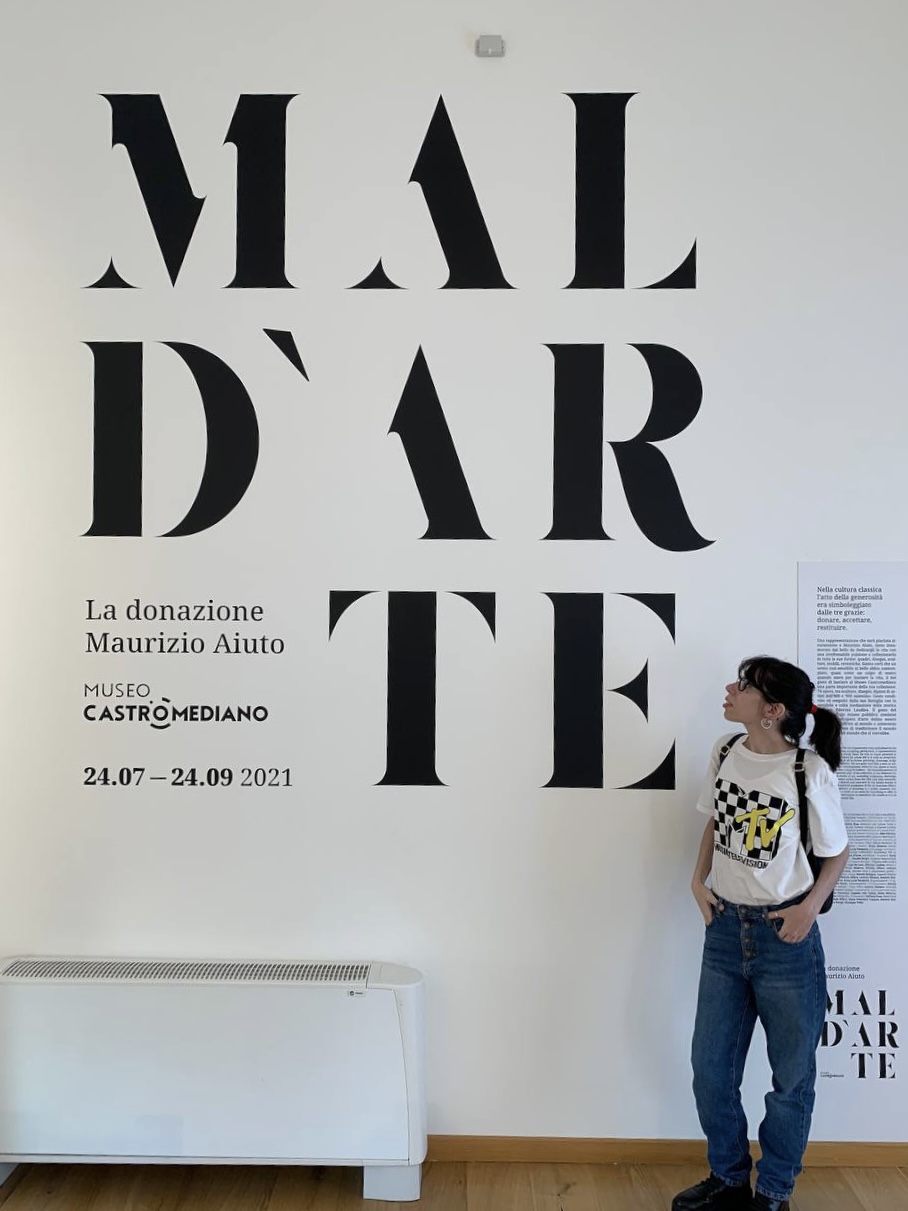
After obtaining the high school languages diploma, she continued her studies graduating in Art History at the University of Salento, with a bilingual thesis on the Pre-Raphaelites. Since then, she has been actively contributing as a columnist and collaborator with national blogs and with local magazines and TV programs.






NO COMMENT